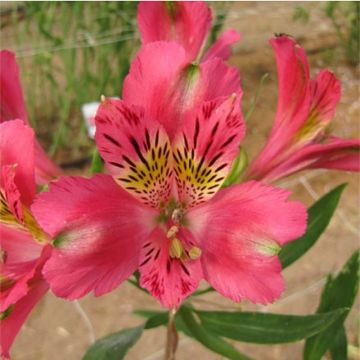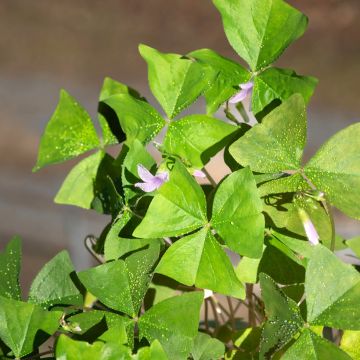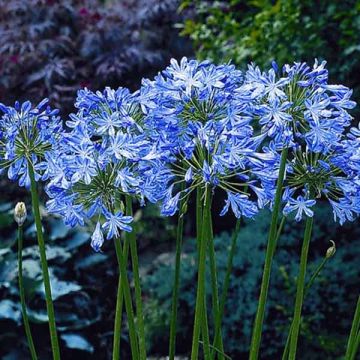

Hymenocallis festalis Sulphur Queen - Spider Lily
Hymenocallis festalis Sulphur Queen - Spider Lily
Hymenocallis festalis Sulphur Queen
Spider Lily, Peruvian Daffodil, Ismene, Sea Daffodil
Gorgeous, elegant, fragrant, beautiful development even when planted outside of the optimal period.
Christine, 24/07/2022
This item cannot be shipped to the selected country
Delivery charge from €5.90
More information
Schedule delivery date,
and select date in basket
This plant carries a 6 months recovery warranty
More information
We guarantee the quality of our plants for a full growing cycle, and will replace at our expense any plant that fails to recover under normal climatic and planting conditions.
From €5.90 for pickup delivery and €6.90 for home delivery
Express home delivery from €8.90.


Does this plant fit my garden?
Set up your Plantfit profile →
Description
The 'Sulphur Queen' Ismene, also known as Hymenocallis festalis, is a rare perennial bulb in our latitudes. Its beautiful trumpet-shaped flowers initially resemble daffodils or lilies, hence their nicknames. But their lovely yellow cups are streaked with fine green tongues and surrounded by a row of slender petals that extend beyond them, giving them a much more exotic appearance. With a subtly spicy fragrance, this tender plant that blooms in summer often prefers to be grown in a pot. This way, you can keep it warm, close to your eyes and nose.
'Sulphur Queen' is a cross between Hymenocallis amancaes and Hymenocallis narcissiflora. It is also known as the Peruvian Daffodil. This name tells us about the genus's origins. Hymenocallis actually come from Central and South America. They like well-drained soils that do not dry out and remain moist, but also do not retain excess water. They prefer rich soils and warm, sunny exposures. In most of our regions, growing them in a pot is recommended, as this tender plant cannot tolerate frost. If you want to plant it in a bed, you will need to remove the bulb in autumn and store it.
This 'Sulphur Queen' has thick, glossy, lanceolate leaves. They are rather wide (3-4 cm (1-2in)), stand up to 30-40 cm (12-16in) tall, and encircle the base of the flower stalks. These stalks are made up of large cylindrical stems that can reach 50 to 60 cm (20 to 24in) in height, topped with 2 to 3 flowers that bloom from June onwards (depending on temperatures). The trumpet-shaped cup is actually made up of fused petaloid stamens. They are fringed at the tip, with a beautiful sulphur yellow color and streaked with green filaments that shoot out from a heart of the same shade. All of this is further enhanced by a row of slender petals that extend beyond in the background, giving it a dynamic fireworks-like appearance. Very elegant, they can be used to create vibrant bouquets with a delightful fragrance.
The Hymenocallis festalis 'Sulphur Queen' is a delicate plant that is best monitored and placed in a conservatory or sunny courtyard. Among cacti, succulents, and other tender plants, it will bring a lovely light and a welcome touch of exoticism to our latitudes.
Report an error about the product description
Hymenocallis festalis Sulphur Queen - Spider Lily in pictures


Plant habit
Flowering
Foliage
Botanical data
Hymenocallis
festalis
Sulphur Queen
Amaryllidaceae
Spider Lily, Peruvian Daffodil, Ismene, Sea Daffodil
Cultivar or hybrid
Other Ismene
Planting and care
Plant your 'Sulphur Queen' Ismene bulbs after the last frost in a sunny or partially shaded location, 10 cm (4in) deep and spaced 10 cm (4in) apart. The soil should be deeply worked and enriched with compost. Ismenes are sensitive to frost. You can leave the bulbs in the ground and mulch them in mild climates with no frosts. In colder regions, the bulbs should be dug up in autumn before the first frost and stored in a cool, dry place.
You can also grow them in pots (1 bulb per 15cm (6in) pot, with the top of the bulb level with the soil) in a good potting mix you regularly fertilise. Bring the pot outside at the end of spring and protect it from frost in winter. In this case, don't forget to water it, but not too much. Ismene doesn't like either lack of water or excess.
Planting period
Intended location
Care
-
, onOrder confirmed
Reply from on Promesse de fleurs
Bulbs to grow in pots
Haven't found what you were looking for?
Hardiness is the lowest winter temperature a plant can endure without suffering serious damage or even dying. However, hardiness is affected by location (a sheltered area, such as a patio), protection (winter cover) and soil type (hardiness is improved by well-drained soil).

Photo Sharing Terms & Conditions
In order to encourage gardeners to interact and share their experiences, Promesse de fleurs offers various media enabling content to be uploaded onto its Site - in particular via the ‘Photo sharing’ module.
The User agrees to refrain from:
- Posting any content that is illegal, prejudicial, insulting, racist, inciteful to hatred, revisionist, contrary to public decency, that infringes on privacy or on the privacy rights of third parties, in particular the publicity rights of persons and goods, intellectual property rights, or the right to privacy.
- Submitting content on behalf of a third party;
- Impersonate the identity of a third party and/or publish any personal information about a third party;
In general, the User undertakes to refrain from any unethical behaviour.
All Content (in particular text, comments, files, images, photos, videos, creative works, etc.), which may be subject to property or intellectual property rights, image or other private rights, shall remain the property of the User, subject to the limited rights granted by the terms of the licence granted by Promesse de fleurs as stated below. Users are at liberty to publish or not to publish such Content on the Site, notably via the ‘Photo Sharing’ facility, and accept that this Content shall be made public and freely accessible, notably on the Internet.
Users further acknowledge, undertake to have ,and guarantee that they hold all necessary rights and permissions to publish such material on the Site, in particular with regard to the legislation in force pertaining to any privacy, property, intellectual property, image, or contractual rights, or rights of any other nature. By publishing such Content on the Site, Users acknowledge accepting full liability as publishers of the Content within the meaning of the law, and grant Promesse de fleurs, free of charge, an inclusive, worldwide licence for the said Content for the entire duration of its publication, including all reproduction, representation, up/downloading, displaying, performing, transmission, and storage rights.
Users also grant permission for their name to be linked to the Content and accept that this link may not always be made available.
By engaging in posting material, Users consent to their Content becoming automatically accessible on the Internet, in particular on other sites and/or blogs and/or web pages of the Promesse de fleurs site, including in particular social pages and the Promesse de fleurs catalogue.
Users may secure the removal of entrusted content free of charge by issuing a simple request via our contact form.
The flowering period indicated on our website applies to countries and regions located in USDA zone 8 (France, the United Kingdom, Ireland, the Netherlands, etc.)
It will vary according to where you live:
- In zones 9 to 10 (Italy, Spain, Greece, etc.), flowering will occur about 2 to 4 weeks earlier.
- In zones 6 to 7 (Germany, Poland, Slovenia, and lower mountainous regions), flowering will be delayed by 2 to 3 weeks.
- In zone 5 (Central Europe, Scandinavia), blooming will be delayed by 3 to 5 weeks.
In temperate climates, pruning of spring-flowering shrubs (forsythia, spireas, etc.) should be done just after flowering.
Pruning of summer-flowering shrubs (Indian Lilac, Perovskia, etc.) can be done in winter or spring.
In cold regions as well as with frost-sensitive plants, avoid pruning too early when severe frosts may still occur.
The planting period indicated on our website applies to countries and regions located in USDA zone 8 (France, United Kingdom, Ireland, Netherlands).
It will vary according to where you live:
- In Mediterranean zones (Marseille, Madrid, Milan, etc.), autumn and winter are the best planting periods.
- In continental zones (Strasbourg, Munich, Vienna, etc.), delay planting by 2 to 3 weeks in spring and bring it forward by 2 to 4 weeks in autumn.
- In mountainous regions (the Alps, Pyrenees, Carpathians, etc.), it is best to plant in late spring (May-June) or late summer (August-September).
The harvesting period indicated on our website applies to countries and regions in USDA zone 8 (France, England, Ireland, the Netherlands).
In colder areas (Scandinavia, Poland, Austria...) fruit and vegetable harvests are likely to be delayed by 3-4 weeks.
In warmer areas (Italy, Spain, Greece, etc.), harvesting will probably take place earlier, depending on weather conditions.
The sowing periods indicated on our website apply to countries and regions within USDA Zone 8 (France, UK, Ireland, Netherlands).
In colder areas (Scandinavia, Poland, Austria...), delay any outdoor sowing by 3-4 weeks, or sow under glass.
In warmer climes (Italy, Spain, Greece, etc.), bring outdoor sowing forward by a few weeks.













































